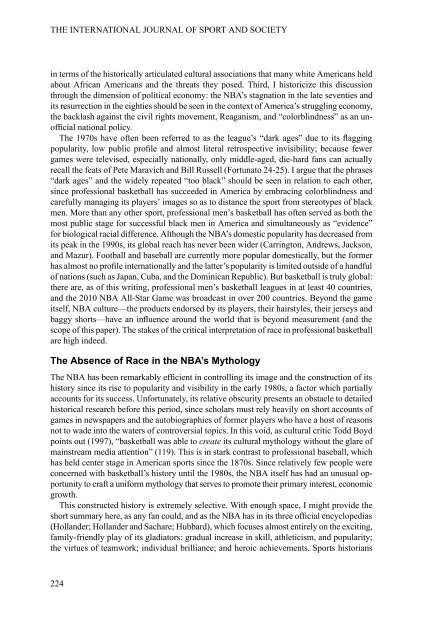Download - University of Minnesota
Download - University of Minnesota
Download - University of Minnesota
Create successful ePaper yourself
Turn your PDF publications into a flip-book with our unique Google optimized e-Paper software.
THE INTERNATIONAL JOURNAL OF SPORT AND SOCIETY<br />
in terms <strong>of</strong> the historically articulated cultural associations that many white Americans held<br />
about African Americans and the threats they posed. Third, I historicize this discussion<br />
through the dimension <strong>of</strong> political economy: the NBA’s stagnation in the late seventies and<br />
its resurrection in the eighties should be seen in the context <strong>of</strong> America’s struggling economy,<br />
the backlash against the civil rights movement, Reaganism, and “colorblindness” as an un<strong>of</strong>ficial<br />
national policy.<br />
The 1970s have <strong>of</strong>ten been referred to as the league’s “dark ages” due to its flagging<br />
popularity, low public pr<strong>of</strong>ile and almost literal retrospective invisibility; because fewer<br />
games were televised, especially nationally, only middle-aged, die-hard fans can actually<br />
recall the feats <strong>of</strong> Pete Maravich and Bill Russell (Fortunato 24-25). I argue that the phrases<br />
“dark ages” and the widely repeated “too black” should be seen in relation to each other,<br />
since pr<strong>of</strong>essional basketball has succeeded in America by embracing colorblindness and<br />
carefully managing its players’ images so as to distance the sport from stereotypes <strong>of</strong> black<br />
men. More than any other sport, pr<strong>of</strong>essional men’s basketball has <strong>of</strong>ten served as both the<br />
most public stage for successful black men in America and simultaneously as “evidence”<br />
for biological racial difference. Although the NBA’s domestic popularity has decreased from<br />
its peak in the 1990s, its global reach has never been wider (Carrington, Andrews, Jackson,<br />
and Mazur). Football and baseball are currently more popular domestically, but the former<br />
has almost no pr<strong>of</strong>ile internationally and the latter’s popularity is limited outside <strong>of</strong> a handful<br />
<strong>of</strong> nations (such as Japan, Cuba, and the Dominican Republic). But basketball is truly global:<br />
there are, as <strong>of</strong> this writing, pr<strong>of</strong>essional men’s basketball leagues in at least 40 countries,<br />
and the 2010 NBA All-Star Game was broadcast in over 200 countries. Beyond the game<br />
itself, NBA culture—the products endorsed by its players, their hairstyles, their jerseys and<br />
baggy shorts—have an influence around the world that is beyond measurement (and the<br />
scope <strong>of</strong> this paper). The stakes <strong>of</strong> the critical interpretation <strong>of</strong> race in pr<strong>of</strong>essional basketball<br />
are high indeed.<br />
The Absence <strong>of</strong> Race in the NBA’s Mythology<br />
The NBA has been remarkably efficient in controlling its image and the construction <strong>of</strong> its<br />
history since its rise to popularity and visibility in the early 1980s, a factor which partially<br />
accounts for its success. Unfortunately, its relative obscurity presents an obstacle to detailed<br />
historical research before this period, since scholars must rely heavily on short accounts <strong>of</strong><br />
games in newspapers and the autobiographies <strong>of</strong> former players who have a host <strong>of</strong> reasons<br />
not to wade into the waters <strong>of</strong> controversial topics. In this void, as cultural critic Todd Boyd<br />
points out (1997), “basketball was able to create its cultural mythology without the glare <strong>of</strong><br />
mainstream media attention” (119). This is in stark contrast to pr<strong>of</strong>essional baseball, which<br />
has held center stage in American sports since the 1870s. Since relatively few people were<br />
concerned with basketball’s history until the 1980s, the NBA itself has had an unusual opportunity<br />
to craft a uniform mythology that serves to promote their primary interest, economic<br />
growth.<br />
This constructed history is extremely selective. With enough space, I might provide the<br />
short summary here, as any fan could, and as the NBA has in its three <strong>of</strong>ficial encyclopedias<br />
(Hollander; Hollander and Sachare; Hubbard), which focuses almost entirely on the exciting,<br />
family-friendly play <strong>of</strong> its gladiators: gradual increase in skill, athleticism, and popularity;<br />
the virtues <strong>of</strong> teamwork; individual brilliance; and heroic achievements. Sports historians<br />
224

















